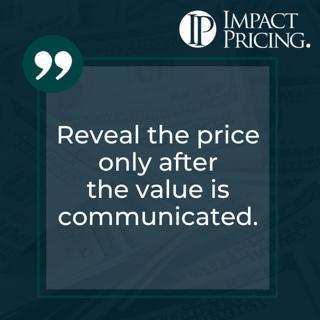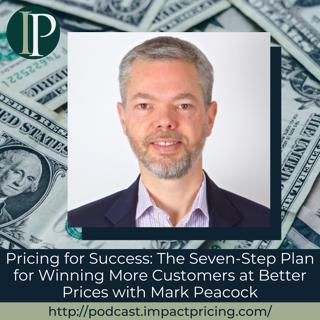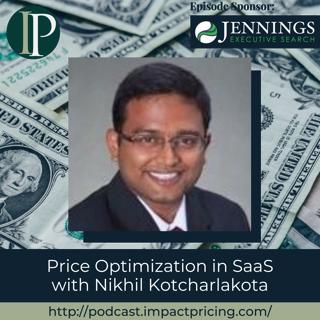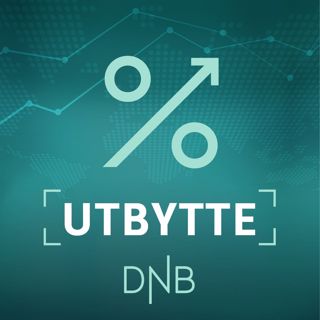
Pricing Table Topics: 10 of Diamonds – Reveal the Price Only After the Value Is Communicated
This is the 10 of Diamonds from the Selling Value card deck. You should reveal the price only after the value is communicated. What happens is, when our buyers hear the price, at that moment, they're making a decision. Is the price too high or too low? Is it worth it? What decision am I going to make? Am I going to spend more time with this? Now, what typically happens is, imagine you're going to buy a pair of Levi's at the retail store, and you walk into the store and you see the price is $60. Well, no one communicated the value to you, but you probably already had a pretty good feeling for what the value of Levi's really is to you. And so, you know if that price is high or low, and if it's worth it to you. But now, imagine you're a B2B salesperson and you walk in the door and you say, 'Our product is a hundred thousand dollars.' And the buyer instantly says, 'Don't have the budget. That's too expensive. Not going to buy it.' And they don't pay attention anymore. You are done working with that buyer. But if instead, we spent the time to say, 'What problems are you truly trying to solve? What's the value to the company if we can solve those problems?' And you find out that the value to the company is truly a million or 10 million dollars. Then when you say the number a hundred thousand, they say, 'Oh, that's probably worth it. Let's see if we can figure out how to do that.' It completely changes the perception in the buyer's mind. So, what we have to do is make sure our buyers have a good understanding of what the value of our solution truly is before we tell them the price. We hope you enjoy this example of Pricing Table Topics. What you just heard was done without a script. If you want to get better at speaking about pricing and value, grab a deck of our cards, pick a card, read the saying, then talk for one to two minutes about what the card says. You will become a better speaker and expert. If you have any questions or feedback, please email me, mark@impactpricing.com. Now, go make an impact. Connect with Mark Stiving: Email: mark@impactpricing.com LinkedIn: https://www.linkedin.com/in/stiving/
18 Jan 20232min

Disrupting Pricing with AI: Insights from Steven Forth
Steven Forth is a Partner in Ibbaka, a strategic pricing advisory firm. He was CEO of LeveragePoint Innovations Inc., a SaaS business designed to help companies create and capture value. Steven is what I consider one of the great pricing thinkers in our industry. In this episode, Steven talks about AI and how it is impacting the world of pricing. He also shares some of the improvements we could expect from AI infrastructures in the near future. Why you have to check out today’s podcast: Find out how the emergence of AI improves and disrupts the pricing profession and the trade as a whole Learn how to extract the best and most comprehensive solutions from AI tools Get an idea on how the “big 3” of cloud services might price for their AI services in considering their current pricing models “Many billions of dollars being invested in AI last year, next year, this year. The overall investment is going to be probably in the neighborhood of $300 billion in 2023. So, if we were investing that much money, we better get some value back. And the companies investing that money need to be able to price that value they're creating.” – Steven Forth Topics Covered: 02:10 – The questions that need to be answered about the impacts of AI in pricing 04:06 – Examples of existing value proposition that AI is improving 07:10 – Examples of existing value proposition that AI is disrupting 10:44 – Is the emergence of AI a challenge to the pricing profession? 12:08 – Can open AI soon generate value models that are better than experts create? 15:58 – Why and how large language models such as Chat GPT are taking over 18:06 – How to guide an AI in giving you comprehensive answers 19:34 – What the pricing of major AI infrastructures looks like 21:02 – How Amazon, Google and Microsoft would possibly price for AI considering their present pricing models 23:28 – Will there be different strengths in the AI of infrastructures Amazon, Google and Microsoft? 24:55 – Differences in AIs: Would different Ais give out different answers to the same questions? 26:19 – Could AI effectively learn pricing from human pricing experts? 28:02 – How Ais could start making outcome-based pricing more practical 32:03 – Connect with Steven Forth Key Takeaways: “People who are skilled in the art [of trade] understand how to come up with pricing for disruptive innovation.” – Steven Forth “Understanding the limitations of these large language models, which GPT is an example of, is also important. And we can come to that. But let's not forget that the limitations today are not the limitations in six months.” – Steven Forth “That, I think, is actually one of the emerging skills: To be able to structure a sequence of questions that will guide an AI in giving you meaningful answers.” – Steven Forth People / Resources Mentioned: Ibbaka – https://www.ibbaka.com/ DALL·E 2 – https://openai.com/dall-e-2/ Chat GPT – https://openai.com/blog/chatgpt/ Amazon Web Services – https://aws.amazon.com/ Google Cloud Services – https://cloud.google.com/ Microsoft Azure – https://azure.microsoft.com/en-us NVIDIA – https://www.nvidia.com/en-us/deep-learning-ai/products/solutions/ Connect with Steven Forth: LinkedIn: https://www.linkedin.com/in/stevenforth/ Email: steven@ibbaka.com Connect with Mark Stiving: LinkedIn: https://www.linkedin.com/in/stiving/ Email: mailto:mark@impactpricing.com
16 Jan 202333min

Blogcast: Black Friday and Price Elasticity
This is an Impact Pricing Blog published on December 7, 2022, turned into an audio podcast so you can listen on the go. Read Full Article Here: https://impactpricing.com/blog/black-friday-and-price-elasticity/ If you have any feedback, definitely send it. You can reach us at mark@impactpricing.com. Now, go make an impact. Connect with Mark Stiving: Email: mark@impactpricing.com LinkedIn: https://www.linkedin.com/in/stiving/
13 Jan 20232min

Pricing Table Topics: 10 of Clubs – What Value Conversation Demonstrates
This one is the 10 of Clubs from the Selling Value card deck. Yes, a value conversation is a great way to build a relationship with your customers, with your buyers. Face it, your buyer probably hasn't put together a business case for what it is they're trying to buy. And yet, it makes a lot of sense for them to have one. It gives them more confidence, they're making the right decision. It gives them the ability to sell up in the organization in case they have to convince someone else to give them the resources. It provides the justification inside the company that they're doing a good thing for the company. And so, they really want to create a business case. But they probably haven't done it because they didn't think about it. They don't really know how. If you can help your buyer write that business case, and that's exactly what selling value means, then you are truly helping the buyer. You're adding a lot of value to that buyer's decision process, to their career, to their prestige inside the organization. Having a value conversation not only helps you understand how much value there is in that situation, but it helps you build the stronger relationship with your buyers. So, have value conversations. They truly demonstrate that you care about your buyer. We hope you enjoy this example of Pricing Table Topics. If you want to get better at speaking, especially about pricing and value, grab a deck of our cards. Pull a random card and read the saying. Then talk for one to two minutes about what that card says. If you have any questions or feedback, please email me, mark@impactpricing.com. Now, go make an impact. Connect with Mark Stiving: Email: mark@impactpricing.com LinkedIn: https://www.linkedin.com/in/stiving/
11 Jan 20232min

Pricing for Success: The Seven-Step Plan for Winning More Customers at Better Prices with Mark Peacock
Mark Peacock has been a pricing consultant since 2017. Currently, he is the managing director of Price Maker, a company that helps their businesses differentiate themselves from the competition by means of having a smarter pricing. He is also about to release his new book titled “Pricing for Success: The Seven-Step Plan for Winning More Customers at Better Prices” In this episode, Mark talks about what’s written in his newest book, “Pricing for Success: The Seven-Step Plan for Winning More Customers at Better Prices”. He shares the fundamental ideas behind the seven steps and gives insightful sample situations in which the seven steps can be applied. Why you have to check out today’s podcast: Get a general idea of what’s in Mark’s new book, Pricing for Success: The Seven-Step Plan for Winning More Customers at Better Prices Learn why it’s okay to have multiple pricing models on a single product Find out why it is the best time for you to raise your prices “Take the time to do your pricing strategy properly, and put your prices up because it is the most powerful lever you can use to increase profitable growth.” – Mark Peacock Topics Covered: 01:27 – How Mark got into pricing 02:35 – The reason why Mark wrote his book, “Pricing for Success: The Seven-Step Plan for Winning More Customers at Better Prices” 03:42 – Step 1: Where do you want to go? 06:43 – Step 2: Know what your customers think about you 08:02 – Step 3: Being aware of your competition 11:02 – Step 4: Product 13:13 – Step 5: Pricing 15:45 – Mark Peacock’s thoughts on having more than one pricing model for a product 17:17 – Step 6: Proposition 19:21 – Mark Peacock’s favorite behavioral economics example 22:47 – Step 7: Profit 24:53 – How Mark would address the issue of credit grabbing among departments in cases of sales improvement 28:59 – Mark’s pricing advice 30:09 – Connect with Mark Peacock Key Takeaways: “Pricing, ultimately, is always a subset of business strategy, of your company goals. So, you've got to be clear. You got to know where you want to get to. Otherwise, you'll end up floundering with your pricing.” – Mark Peacock “Product and price are two sides of the same coin. When I buy products for a price, I want to know what I get as a customer and equally as a seller, you need to know everything that's included in your product offering.” – Mark Peacock “Without changing the pricing, you can achieve an effective increase in prices of 4% by changing how you present the prices. And I think this whole question of how we present pricing is just as important as ‘What's the number? What's the strategy?’ Because it makes such a difference.” – Mark Peacock “Having a clearly written pricing policy is such an important thing. And I literally say in my book, ‘Write it down’. And it doesn't have to be long, it doesn't have to be complicated.” – Mark Peacock People / Resources Mentioned: Pricing for Success: The Seven-Step Plan for Winning More Customers at Better Prices – https://www.barnesandnoble.com/w/pricing-for-success-mark-peacock/1142840523 Selling Value: How to Win More Deals at Higher Prices – https://www.amazon.com/Selling-Value-Deals-Higher-Prices/dp/1737655217 Connect with Mark Peacock: LinkedIn: https://www.linkedin.com/in/mark-peacock-the-pricing-coach/ Email: mark@pricemaker.co.uk Connect with Mark Stiving: LinkedIn: https://www.linkedin.com/in/stiving/ Email: mailto:mark@impactpricing.com
9 Jan 202332min

Blogcast: Thoughts on Black Friday Pricing
This is an Impact Pricing Blog published on November 30, 2022, turned into an audio podcast so you can listen on the go. Read Full Article Here: https://impactpricing.com/blog/thoughts-on-black-friday-pricing/ If you have any feedback, definitely send it. You can reach us at mark@impactpricing.com. Now, go make an impact. Connect with Mark Stiving: Email: mark@impactpricing.com LinkedIn: https://www.linkedin.com/in/stiving/
6 Jan 20233min

Pricing Table Topics: 10 of Hearts – You and Your Buyer Must Work Together
This is the 10 of Hearts from the Selling Value card deck. You and your buyer have to work together if you truly want to know how much value is there. Face it, you know a lot about your product, but you don't really know the buyer's situation. You don't know how much revenue they make. You don't know how much money they're losing because they're solving, or haven't solved a specific problem. You don't know how bad that problem is. In order for you to figure out how much value they're going to get, you need a lot of information from that buyer. On the other hand, the buyer has no idea how much value they're going to get either because they've probably never bought something like your product before. They've not worked with many different customers and seen the different applications and the different problems, and they probably haven't thought through all of the sub-problems that you can solve. And so, if together we work trying to figure out what is the true value of our product, then we feel better because we now understand we're helping them make a really good decision. They feel better because they're trying to decide, is this a place where I want to spend my resources or should I spend them someplace else? Or maybe the person you're talking to has to create a business case to be able to sell it higher in the organization. In all of these cases, it makes so much sense for both of us to understand the value of solving their problems, and that only happens when we work together. We hope you enjoyed this example of pricing table topics. If you want to get better at speaking, especially about pricing and value, grab a deck of our cards, pull a random card, read the saying, and then talk for one to two minutes about what that card says. If you have any questions or feedback, please email me, mark@impactpricing.com. Now, go make an impact. Connect with Mark Stiving: Email: mark@impactpricing.com LinkedIn: https://www.linkedin.com/in/stiving/
4 Jan 20232min

Price Optimization in SaaS with Nikhil Kotcharlakota
Nikhil Kotcharlakota is a civil engineer by profession. He worked for Electrolux for eight years where he was head of pricing for almost two years. Currently, he is a co-founder of PriceOps, a company that aims to provide an all-in-one pricing solution for SaaS companies. In this episode, Nikhil talks about how his experience at Electrolux changed the way he looked at pricing. He also discusses about his company, PriceOps, and how they aim to provide a complete, optimized pricing solution to SaaS companies using different pricing models. Why you have to check out today’s podcast: Learn how usage data can be utilized to optimize billing and pricing Discover the possibility of SaaS companies effectively using outcome-based pricing models Learn the difference between per-user model and per active user model and when to use them “Having the focus on price and getting value out of what you're offering is a very important thing.” – Nikhil Kotcharlakota Topics Covered: 01:30 – How Nikhil got into pricing 03:01 – The work that Nikhil’s company, PriceOps does 05:59 – How PriceOps plans to utilize usage data for billing and pricing 07:05 – PriceOps’ biggest challenge: using outcome-based pricing model for SaaS companies 11:19 – The other pricing models that PriceOps is eyeing besides usage-based and outcome-based 12:24 – How PriceOps aims to recommend whether to use per-user model or per active user model 15:12 – What Nikhil learned as he shifted from traditional pricing to subscription-based pricing 18:38 – Why Nikhil loves pricing operations 20:17 – Without execution, pricing strategy does not matter 20:50 – Nikhil’s pricing advice 22:02 – The revenue point at which businesses should hire a pricing person 23:54 – Connect with Nikhil Kotcharlakota Key Takeaways: “The best part about pricing is it's always at the center of the strategy or you'll get to work with a lot of teams; product management, sales, accounting, finance, I mean, literally every team in the company.” – Nikhil Kotcharlakota “Companies have realized the consumer is king. So, they're trying to build an experience for the consumer so they continue to buy the same product over and over again.” – Nikhil Kotcharlakota “If the operations are not set up properly or if there are no processes for the pricing team, a strategy might be there, but they may not be able to execute on the strategy, which will then result in loss in price or price leakage.” – Nikhil Kotcharlakota People / Resources Mentioned: PriceOps: https://www.linkedin.com/company/priceops/ Win, Keep, Grow: How to Price and Package to Accelerate Your Subscription Business: https://www.amazon.com/Win-Keep-Grow-Accelerate-Subscription/dp/1631954784 Connect with Nikhil Kotcharlakota: LinkedIn: https://www.linkedin.com/in/nikhilkotcharlakota/ Email: nikhil@priceops.net Connect with Mark Stiving: LinkedIn: https://www.linkedin.com/in/stiving/ Email: mailto:mark@impactpricing.com
2 Jan 202325min






















